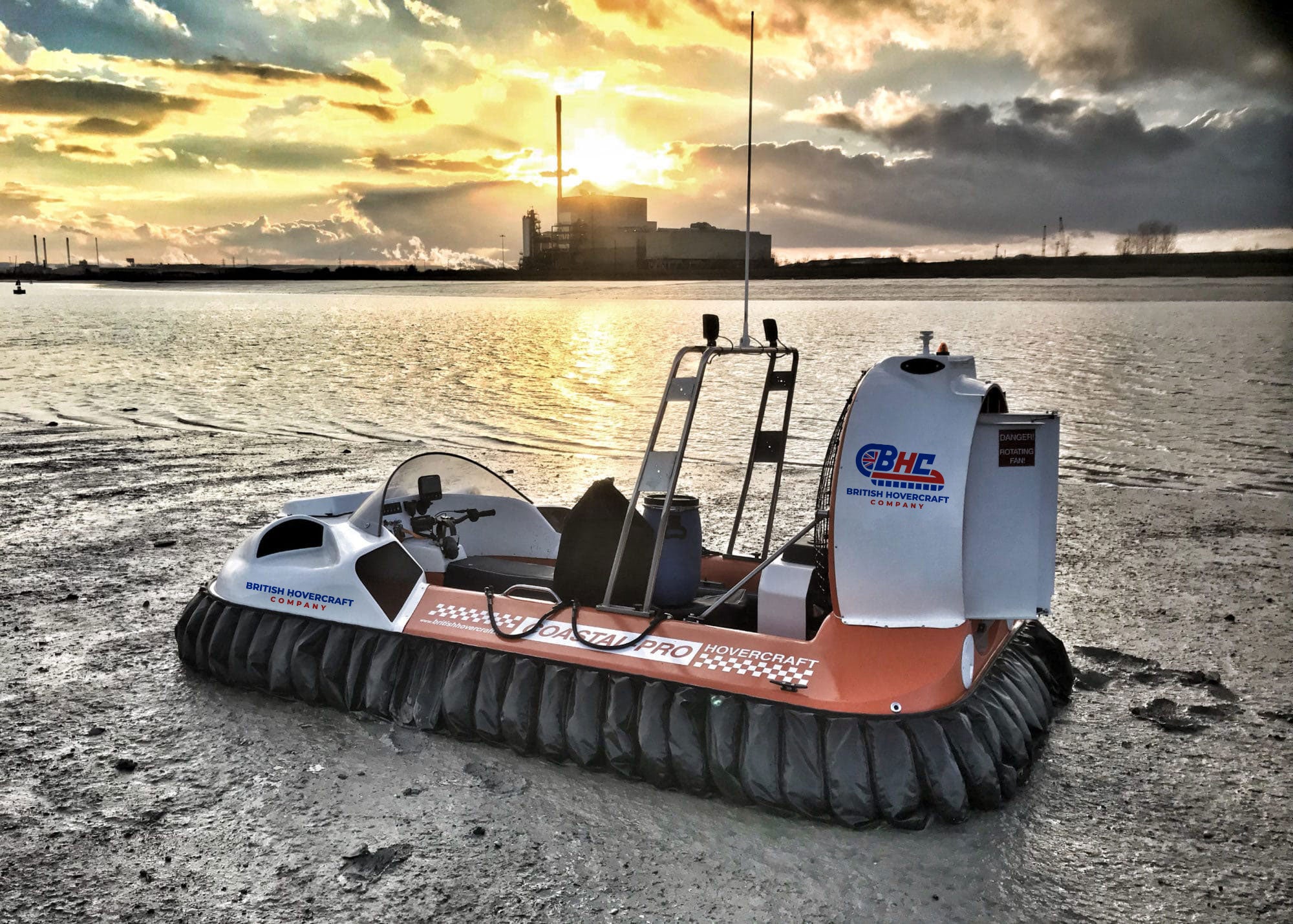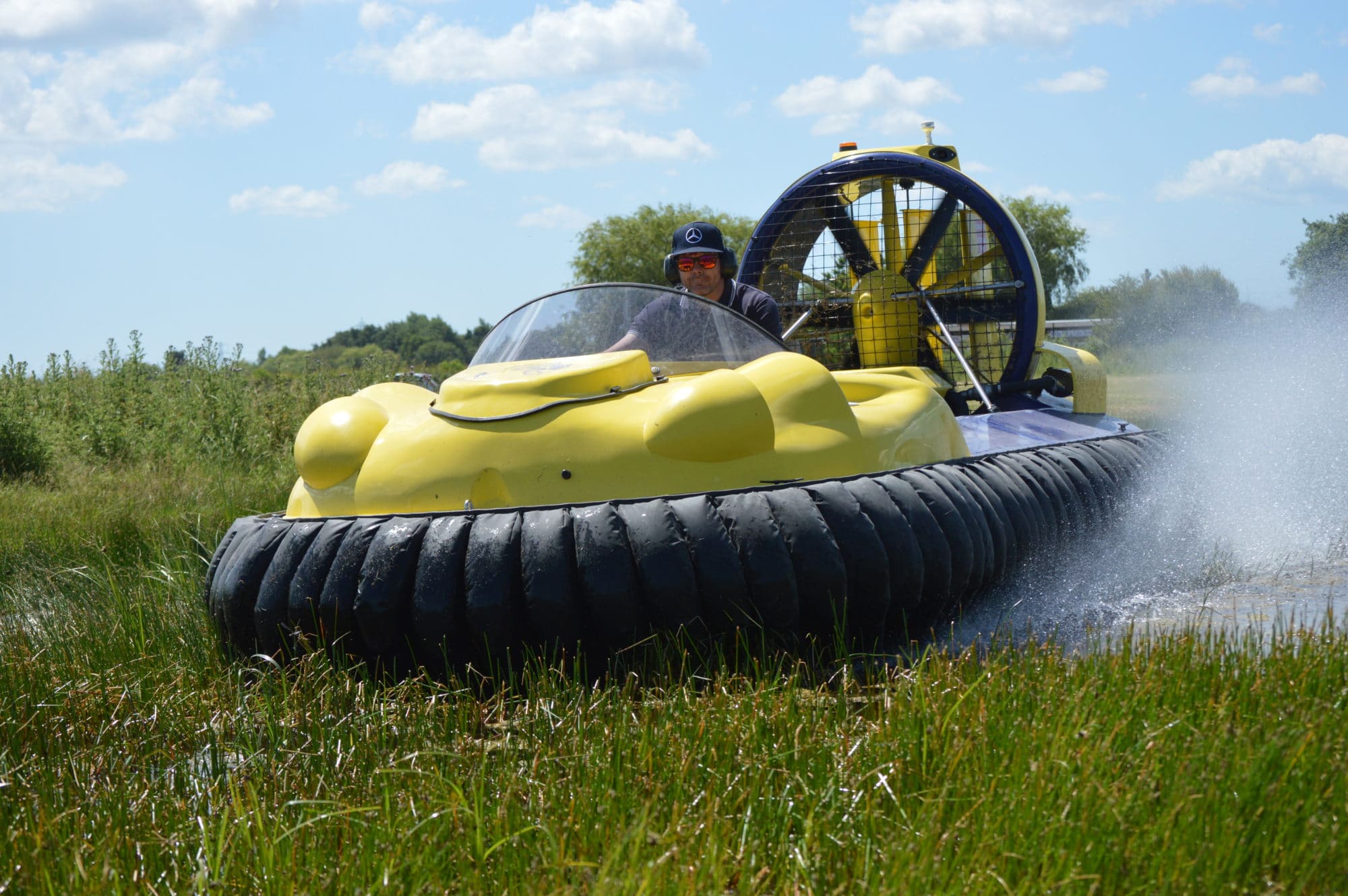The Coastal-Pro is the quietest production hovercraft at 74dba. It is ideal for any commercial purpose and has amazing control for a twin-engine craft. Available for a range of operations from cruising to surveys it has excellent fuel consumption and ample power to negotiate even the toughest terrain. Also used as a recreational hovercraft, The Coastal-Pro really is a hovercraft for all applications.

SEATING CAPACITY
3-4 People

ENGINE
Thrust 993cc Briggs & Stratton 4 stroke / Lift 540cc Briggs & Stratton

SPEED
35mph / 56kph / 30kn
COASTAL-PRO
Maximum Speed - Approx 35mph/56km/h
Cruising Speed - Approx 25mph/40km/h
Range/Endurance - Approx 3 hours - 80miles/128kms
Payload - Up to 770lbs/350kgs
Passengers - No more than 4, subject to weight limitation.
Overload Capacity - Approx 880lbs/400kgs
Length - 13'8"/4.3m
Width - 7'0"/2.10m
Height - 5'6"/1.7m
Weight - Approx 815lbs/370kgs
Engines - 993cc & 540cc
Sound - 70dbA (25m) at cruising speed. Maximum 78dbA at full power (loudest possible reading)
Operating Conditions - Preferably no more than an 18-24” ‘chop’ depending on load etc.




A brand new design in 2014, it quickly received a design award from the Hovercraft Club of America for its clever hull design. With independent control of the thrust and lift engines, you have enormous control over the craft, especially useful at low speeds in a commercial or space-restricted environment where precise steering is so important.
The separate lift system also allows a generous load capacity for such a compact hovercraft and the Coastal-Pro is best described as a 3-4 seat hovercraft as it has a capacity of around 325kgs in favourable conditions. It also contributes to the exceptionally low-noise levels – at cruising speed, 74dbA is low enough to meet EU standards for recreational boats!
It’s a great looking hovercraft, measures 4.2m x 2.1m and just like the Marlin & Snapper models, the ‘thrust’ power comes from the amazingly robust Vanguard V-Twin, together with a single cylinder engine whirring away providing lift inside the noise-deadening front bonnet. The thrust fan is large, and very slow rotating, which keeps noise levels firmly under control, and retains the proven transmission system from the Marlin.
With 30cms of lift, the Coastal-Pro has generous obstacle clearance and is very nimble for a craft of its size. It makes for a great recreational hovercraft, able to operate without excessive noise giving any offence to people nearby, carry a decent load and cruise effortlessly over any sealed surface such as sand, mudflats, water and ice.
Also available is a longer version called the ‘Coastal-Pro XL.’ This is the same basic craft with an additional 65cms (26”) in the passenger compartment. This means that load capacity is increased, at the cost of some of the regular hovercraft’s ‘sporty personality,’ making it ideal for commercial operations in open locations such as estuaries, mudflats and frozen rivers and lakes. Just like the regular Coastal-Pro, it is available to either standard or MACV specification. The XL has a larger V-Twin lift engine and comes as standard with an upgraded thrust engine to push along the extra load it’s capable of lifting.
Whether you want a cruising and recreational hovercraft with extra capacity, a utility craft with a practical purpose, a light commercial hovercraft for survey/crew transfer or emergency standby, or even a mud or ice rescue hovercraft – then the Coastal-Pro is the small hovercraft you’ve been waiting for!

Want to be wowed?
Try before you buy at regular demonstration days down here at Sandwich - why not come along and try one out?
Further Info & Tech Specs
Below is a full breakdown of everything you might need to know about the Coastal Pro.
Engine & Transmission
The Coastal-Pro uses two 4 stroke engines, one for lift, one for thrust. The thrust engine is a Vanguard 37bhp and the lift a smaller 19bhp version. Both, of course, are electric start. The engines both run at low maximum revs, approx. 3800rpm for the thrust engine and 3500rpm for the lift. It can often cruise in decent conditions at 2800rpm. This means noise is low and economy excellent.
Both engines are modified and ‘hoverised’ for marine use. Maintenance is very simple and there are dealers and service centres all over the world for spares and advice. Simple and robust – there’s nothing glamorous or high about these engines which means they’re reliable and easily serviced and repaired by any competent mechanic.
The excellent performance of the Coastal-Pro doesn’t come from big horsepower. It doesn’t need to. The lightweight, reinforced build, ‘clean’ fan ducts and optimised fan setup means that it easily outperforms some hovercraft with two or three times its horsepower. In hovercraft design, weight and efficiency are everything. Lower power allows lower noise levels, more reliable transmission and machinery systems, increased range (less fuel requirement) and lower operating costs.
For commercial applications, both the engines are upgraded, with the 37Efi used for thrust and a larger lift engine. This allows improved weight capacity and an easier life for the engines over long hours.
Whilst included as standard in MACV commercial versions, the Efi is also available for recreational craft at a small extra cost.
Hull, Buoyancy & Skirt
The Coastal-Pro is manufactured from a fiberglass hull, by our team of highly specialised laminators. All hovercraft need to be built to a weight to perform properly, so our hulls are reinforced with Kevlar & Core materials in vulnerable or structural areas, whilst an intelligent lay-up saves weight in less critical locations. The surface is finished with an impregnated gel coat, rather than being sprayed afterwards. This gives a fade-free, very shiny & smooth finish to the hovercraft, which means it washes off easily, whatever you cover it in!
Inside the hull are sections of encapsulated closed-cell foam which, as well as providing buoyancy, also shapes the air within the plenum chamber for best efficiency and performance. The buoyancy provided is adequate to keep the hovercraft afloat, even should it be fully swamped with a full payload aboard.
Hovering approx. 30cms (12ins) in the air on its ‘finger’ or segmented skirt, powered by it’s independent lift system, the Coastal-Pro flies with great ease. This efficiency means that just the skirt ‘tips’ are touching the ground and as a result of this almost frictionless seal, performance is improved, and wear reduced. Skirt wear is something that first-time owners and commercial operators are often concerned about but in actual fact, is simply not an issue. Think of the skirt like the tyres on a car. How you drive it and the surface you use it on will effect how long it lasts. The Coastal-Pro skirt comprises 83 individual segments (93 for the XL) which has enormous advantages over a ‘bag/loop’ design used on large hovercraft. Any damage or excessive wear is localised, and quickly and easily repaired – it takes just a couple of minutes to change a segment. Being individual segments means the skirt works more effectively and can seal more fully on the land or water which gives the best possible lift and effortless performance. The chances are that you'll do whole days cruising or work without needing to change a segment. As a guideline, we usually find that most recreational customers using their hovercraft on a mix of land, sand, mud and water will get around two years wear from a skirt, and will use a dozen or so spares during that time. New skirt segments inexpensive and can even be repaired if preferred.
UK Commercial Operations
In 2015, the Maritime & Coastguard Agency published the Hovercraft Code of Practice (HCoP) which sets out standards for the commercial operation of hovercraft in UK Waters. For passenger carrying and larger hovercraft, this is great news, as there is finally a method allowing operators to code them without needing to comply with the High-Speed Code, which was effectively impossible for most hovercraft of less than 8m.
What was even more warmly received was the MCA’s introduction of a new category of hovercraft called ‘Ultralight’ into which both the Coastal-Pro and Coastal-Pro XL fall.
When operating in-land (such as giving rides at a show/event, driving events businesses or on private lakes & ponds) there is no requirement to meet MCA standards or restrictions on operations. The issue has always been with operations in Intertidal areas, the coastline & estuaries – ie any tidal/salt water operations where the MCA or river/harbour authorities have control.
The Ultralight category allows hovercraft to operate in a limited commercial capacity in a marine environment where no fare-paying passengers are being carried, so it’s aimed at such operations as:
Intertidaly, Geotechnical, Survey, Geosurvey, Environmental Services, Crew Transfer, Bird Counts Mapping, Water Sampling, Standby & Safety
The key point here is that no fare-paying passengers can be carried. An operator can therefore provide contracted hire-services for crew transfer where crew are briefed and engaged in the operation of the vessel. What it does not allow is for an operator to set up giving rides on Blackpool Sands where passengers are carried.
Restrictions:
Hovercraft must weigh no more than 500kgs unladen weight all BHC hovercraft meet this. Maximum of 4 persons on board. Daylight hours and in good visibility only. Restricted to Category 6 Waters, no more than 0.5 miles from the shore (beyond categorised waters) or in areas which are not capable of being navigated by conventional ships within 3 miles of a safe landing place or within one mile of an appropriately certified support boat. Maximum significant wave height of 0.3m.Suitably qualified crew. Hovercraft prepared to Hovercraft Code standards.
Other Requirements:
An Ultralight is operated as work equipment under Provision and Use of Work Equipment Regulations (PUWER). The owner/operator is responsible for ensuring that suitable risk assessments have been carried out, that appropriate maintenance has been completed and that appropriate training and qualifications etc. are in place in accordance with relevant land or sea-based health and safety regulations.
The code sets out the standards (see info box) and the MACV Hovercraft is built to include such equipment as required. The following (not included but can be supplied) is also required.
Chart or plotter for area of operations. Lifejackets for all crew. 2 Red Flares / 2 Smoke Flares. Signals Table.
Crewing requirements:
Skipper must be qualified to RYA Powerboat II standard, commercially endorsed and have 25 hours instruction/experience.
Summary
The smallest hovercraft are now pieces of work equipment and therefore there is technically no MCA standards to meet for commercial work. Rather, PUWER rules apply. However, it is very likely the local authority will demand the hovercraft is built, prepared and manned to the standards of the code, in order to ensure safe operation.
Additionally, if there was an accident or incident and the operator was found to have failed in his duty to operate safely (for which the Hovercraft code provides the standards) then he may well be open to prosecution.


